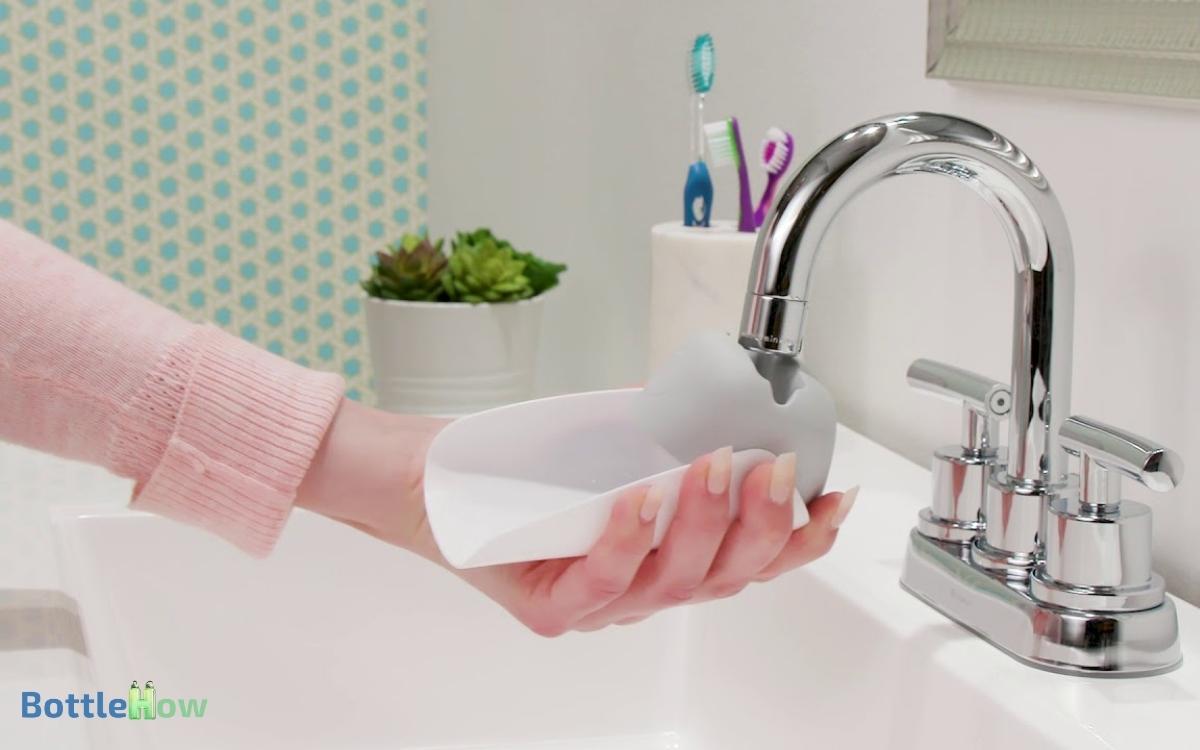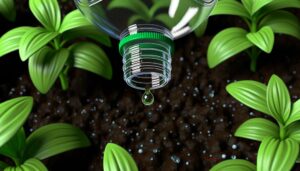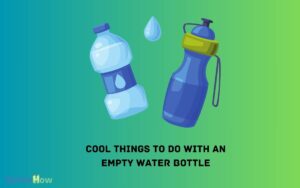Diy Faucet Extender Water Bottle: Step by Step Guide!
Creating a DIY faucet extender from a water bottle is straightforward and effective.
Learn more to optimize your DIY project.

Key Takeaways
Materials Needed
To create a DIY faucet extender using a water bottle, you’ll need a few essential materials to guarantee functionality and durability.
- Plastic water bottle (500ml to 1 liter capacity), free of cracks and punctures
- Pair of sharp scissors or utility knife for precise cutting
- Sandpaper for smoothing rough edges
- Roll of waterproof adhesive tape or small rubber band for attachment to faucet
- Measurement tool to ensure proper fit of extender to faucet
These materials will provide a sturdy, reliable extender, addressing both safety and efficiency in your DIY project.
Preparing the Water Bottle
First, select a suitable water bottle made of durable plastic or metal that fits securely over the faucet.
Next, make sure the bottle is thoroughly cleaned to remove any residues or contaminants.
This preparation step is essential for maintaining hygiene and effective operation of your DIY faucet extender.
Select Suitable Bottle
Selecting a suitable water bottle involves assessing the material’s durability, confirming it fits securely on your faucet, and verifying it’s free from any harmful chemicals.
Begin by choosing a bottle made from robust, BPA-free plastic or stainless steel, as these materials provide both longevity and safety.
Make sure the bottle’s mouth or opening matches the faucet’s diameter to maintain a secure fit, preventing leaks and ensuring efficient water flow. If the fit is too loose or tight, it may result in spills or reduced water flow, making it inconvenient to use. Regularly check for wear and tear, and if necessary, replace Contigo water bottle mouthpiece to ensure a proper seal and hygiene. Choosing a compatible mouthpiece will help maintain the bottle’s functionality and longevity.
Consider the following factors:
- Material Composition: Opt for BPA-free plastic or stainless steel to avoid harmful chemicals.
- Size and Shape: Ensure the bottle’s opening matches your faucet’s size for a tight fit.
- Durability: Select materials known for their strength and resistance to wear and tear.
This analysis guarantees a reliable and safe DIY faucet extender.
Clean Thoroughly
Thoroughly cleaning the water bottle guarantees any residual contaminants or debris are eliminated, providing a hygienic base for your DIY faucet extender. Start by rinsing the bottle with warm water to remove any loose particles.
Use a mild dish soap and a bottle brush to scrub the interior surfaces thoroughly. Pay special attention to the neck and cap areas, as these spots often harbor hidden grime. Rinse the bottle several times to confirm all soap residue is removed.
For a more thorough clean, you can soak the bottle in a solution of one part vinegar to three parts water for about 10 minutes.
Finally, let the bottle air dry completely before use, ensuring no moisture remains that could encourage bacterial growth.
Cutting the Bottle
When cutting the bottle,first gather the necessary tools such as a sharp utility knife or scissors and make sure you follow all safety precautions, including wearing protective gloves.
Next, accurately mark the cutting lines using a permanent marker to guide your cuts.
Finally, smooth any rough edges with sandpaper to prevent potential injuries and guarantee a clean finish.
Tools and Safety Precautions
Carefully gather the essential tools—such as a sharp utility knife, cutting mat, and protective gloves—to ensure both precision and safety when cutting the bottle for your DIY faucet extender. Ensuring you have the right tools and follow safety precautions is vital for a successful project.
Here’s what you’ll need:
- Sharp utility knife: Provides clean, precise cuts.
- Cutting mat: Protects your work surface and enhances stability.
- Protective gloves: Shields your hands from potential injury.
Prioritize a well-lit workspace to clearly see your cutting lines, and always cut away from your body to minimize risk. Hold the bottle firmly but not too tightly to avoid unwanted slips.
Marking Cutting Lines
With your tools and safety precautions in place, it’s time to mark the cutting lines on the water bottle accurately.
Begin by measuring the desired length from the bottle’s neck, where the extender will attach to the faucet. Use a flexible measuring tape for precision.
Once you’ve determined the length, employ a fine-tip permanent marker to draw a clear, continuous line around the bottle.
Make sure the line is level by rotating the bottle while marking. Utilize a ruler or a piece of masking tape as a guide to maintain straightness.
Double-check your measurements and markings before proceeding. Precision at this stage is important to ensure the extender fits correctly and functions effectively.
Smoothing Rough Edges
Begin the cutting process by using a sharp utility knife or a pair of strong scissors to slice through the marked line on the water bottle. Make sure that your cuts are smooth and steady to avoid creating jagged edges.
Once the bottle is cut, it’s important to smooth out any rough edges to prevent potential injury and guarantee a snug fit on the faucet.
To achieve a professional finish, consider the following methods:
- Sandpaper: Use fine-grit sandpaper to gently smooth the cut edges.
- File: A small metal file can be effective for refining the edges.
- Heat: Carefully apply a flame to slightly melt and smooth the edges.
These steps will enhance both safety and functionality, ensuring your DIY faucet extender is both effective and reliable.
Shaping the Extender
To shape the extender, cut the water bottle horizontally at the desired length using a utility knife or sharp scissors.
Ensure the cut is as important as possible to facilitate a smooth water flow. Carefully measure from the bottle’s base to the cutting point to maintain uniformity.
After cutting, inspect the edges for any jagged remnants that could impede functionality. Use fine-grit sandpaper to smoothen these areas, guaranteeing a seamless surface. Precision in cutting and smoothing is vital to avoid water leakage.
Additionally, consider the bottle’s natural curvature when determining the length, as this will impact the water direction. Proper shaping of the extender enhances its effectiveness and ensures it fits securely on the faucet.
Attaching to the Faucet
After meticulously shaping the extender, securely attaching it to the faucet guarantees peak functionality and prevents water leakage. Begin by confirming the faucet’s spout is clean and free from debris.
Align the open end of the extender with the faucet’s spout, ensuring a snug fit to avoid any gaps. The seal’s importance is crucial for excellent performance.
To achieve a secure attachment, consider these steps:
- Use a rubber band or zip tie: Wrap it around the extender and faucet junction to enhance the grip.
- Apply waterproof tape: This adds an extra layer of sealing, preventing any potential leaks.
- Check for a consistent seal: Gently tug on the extender to ensure it remains firmly in place under water pressure.
Following these steps will ensure a reliable connection.
Testing the Extender
Once the extender is securely attached, turn on the faucet to assess its performance and check for any leaks. Observe the water flow, making sure it’s steady and directed properly through the extender.
Inspect all connection points for any signs of dripping water. Should you notice any leaks, tighten the attachment points and use waterproof tape if necessary.
Test the water pressure by varying the faucet’s flow rate; the extender should handle different pressures without dislodging.
Additionally, evaluate the reach of the extender to confirm it meets your intended use. Make sure the water bottle material maintains its shape and integrity under the water’s force.
Conduct a final inspection to verify all components are functioning seamlessly.
Benefits of Using an Extender
Utilizing a faucet extender offers practical advantages, such as improved reach and accessibility for various tasks.
By extending the faucet’s range, you can effectively enhance the ergonomic efficiency of your sink area.
This modification mitigates strain and facilitates easier access for children, the elderly, and individuals with limited mobility.
Consider the following benefits:
- Enhanced Ergonomics: Reduces the need for excessive bending or stretching, minimizing the risk of discomfort or injury.
- Improved Accessibility: Makes it easier for children and those with mobility challenges to use the sink independently.
- Versatility: Allows for the adaptation of existing faucets to accommodate a variety of container sizes and shapes, increasing the functionality of your sink.
These improvements contribute to a more user-friendly and adaptable home environment.
Creative Variations
Explore a range of creative variations for DIY faucet extenders that can be tailored to suit different sink configurations and user needs.
Employing various materials and designs can enhance functionality and adaptability. For instance, you might use flexible tubing for angled faucets or larger bottles for higher water pressure needs.
By customizing the length and shape of the extender, you guarantee excellent water flow and user comfort.
| Variation | Material | Ideal Use |
|---|---|---|
| Flexible Tubing | Silicone | Angled Faucets |
| Large Bottles | Plastic | High Water Pressure |
| Compact Designs | Recycled Plastic | Small Sinks |
| Adjustable Length | Rubber | Different Sink Heights |
| Decorative Extender | BPA-Free Plastic | Aesthetic Considerations |
Conclusion
To wrap up, by transforming a simple water bottle into a DIY faucet extender, you’ve effectively enhanced the faucet’s functionality. This project not only saves you money but also adds a touch of ingenuity to your home.
Remember, just like an 8-track in the digital age, sometimes the simplest solutions are the most impactful. Test the extender thoroughly to guarantee peak performance, and consider exploring creative variations to further customize your setup.






